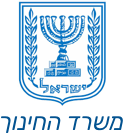On the Closing of the 30 Initial Days of Mourning for the Czchov-Scinawa Rebbe – Rabbi Chaim Yosef Moshe Kanner z”l, Head of the Talmud Torah “Torat Emet” School
On Nisan 29, 5783 (April 20, 2023) Rabbi Chaim Yosef Moshe Kanner z”l, son of Rabbi Avraham Abish Kanner, the Czchow Rebbe, left this world.
By: Devorah Surasky
On the eve of the Chanuka 5783 (2022), as part of the project “From Afar You WIll See the Land: Cyprus – The Last Stop” at Ganzach Kiddush Hashem, an interview was held of the Rebbe, with the participation of his son, the Rebbe Rabbi Yissachar Yoel. In his testimony, the Rebbe recounted his family’s experiences in the days of rage and in exile in Cyprus, from when he was a seventeen-year-old boy. Pieces of his father’s greatness as a leader occupy a prominent place in his memories.
In the lines before you, in which this testimony and other information are interwoven, a picture of a pulsating Jewish life becomes clearer and chapters on leadership, the ability to choose, and unshakable faith, during the immigration period and during the days of the exile in Cyprus are revealed.
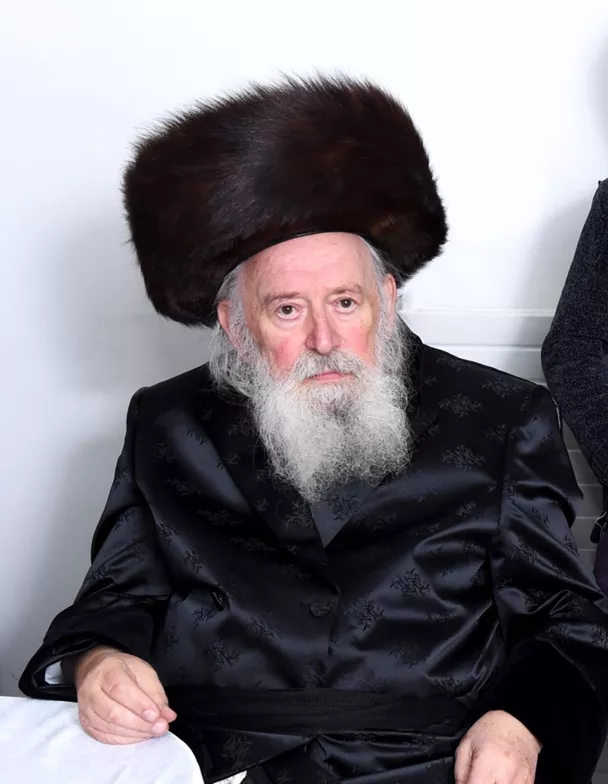
The Czchow-Scinawa Rebbe, Rabbi Chaim Yosef Moshe Kanner
“Rivers Cannot Flood It” (Song of Songs 8:7): Rabbi Avraham Abish Kanner, the Czchow Rebbe
Chapters in leadership and unbroken faith during the upheaval of the stormy days
- “All Your Breakers and Waves” (Psalms 42:8): A Terrible Disaster
“I called the book ‘Ohel Kedoshim’ (Tent of the Martyrs) for the word ‘ohel’ contains the same letters (in Hebrew) as ‘Leah,’ from the name of my holy daughter, Leah Faiga z”l may G-d avenge her blood.” (Rabbi Avraham Abish Kanner, Ohel Kedoshim)
Mefkure – is burned into the mind as a name synonymous with the drowning disaster of over three hundred refugees. The bloody campaign began on August 3, 1944, when three dilapidated ships sailed in a convoy from the port of Constanta in Romania to the Black Sea: “Bulbul”, “Morina,” and “Mefkura”, with more than a thousand refugees on them.
On the 5th of August, shortly after midnight, after it did not respond to the order to stop, the Mefkura was shot at, aiming towards the passengers. [1] Upon the attack, the ship was left without a captain – the captain and his crew abandoned the ship in a lifeboat, the fire spread, and the boat sank into the depths. Five passengers survived.
The Bulbul was also ordered to stop, but after it was detected, it continued on its way. Its upheavals did not end there: due to a storm that broke out at sea, the ship docked in the remote port of Igneada, Turkey, from where the passengers were transported by land to Istanbul.
The Morina sailed without any problems and arrived safely in Istanbul. The immigrants of the two ships made it to Israel from Turkey.
Researchers of the case debate on who is to blame for the drowning of the Mefkure: the Soviets or the Germans? [2]
Among the survivors of the ship were: the Rebbe of Vizhnitz, Rabbi Moshe Yehoshua Hagar – known as the “Yeshuot Moshe” – and his brother-in-law Rabbi Naftali Chaim Adler, who boarded the Morina ship not as planned; Rabbi Yitzhak Yaakov Weiss – known as the “Minchat Yitzchak” – who was late to the voyage due to a malfunction; Rabbi Chaim Druckman z”l, who was late to the ship.
The waters of the Black Sea wiped out the best of Romanian Jewry, the best of the best. Among those who perished were – a group of orphans who were returned from Transnistria; Rebbetzin Henya Friedman – the sister of the Rebbe, Rabbi Eliezer Hagar, known as the “Dameshek Eliezer” of Vizhnitz, who managed with much toil to get her a ticket for the ship; the young Leah Faiga Kanner, the eldest daughter of the Rebbe of Czchow.
“One is obligated to make a blessing on the bad with happiness, just as one blesses on the good,” thus wrote the Rebbe of Czchow, the bereaved father of Leah Faiga, in the introduction to his book “Ohel Kedoshim,” and he also expressed his misfortune in the name of his book “Ohel Kedoshim,” as written above.
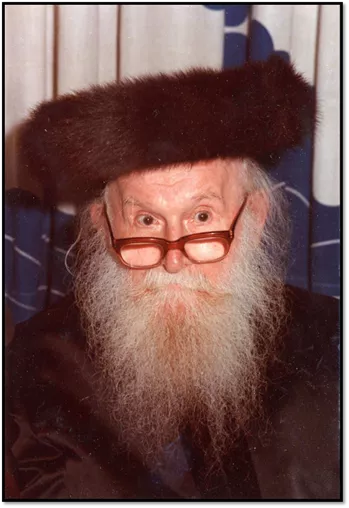
The Czchow Rebbe, Rabbi Avraham Abish Kanner
“…that I would like to build a tent for the martyrs closest to my family who were drowned, killed, and burned in the sanctification of G-d’s Name, and there is no remnant left of them (only two of them), and foremost by my dear young daughter, who was modest and famous for her characteristics and virtues, the martyr Leah Faiga, who was drowned in the sea by the Nazis with another three hundred and sixty-four souls on their way to Israel, may G-d avenge their blood” (ibid., introduction [3]).
The last moments of her life were witnessed by the passengers of the ships at the location of her drowning. They said that they saw the girl struggling with the waves while she was holding a Torah and kept it from falling into the water. This book was a family Torah – an ember that survived the pogrom in Iasi – and was given to her by her father in order to bring to the Land of Israel.
The righteousness of the law and faith wrapped in the pain of bereavement are a small porthole to the enormous greatness and leadership of the Rebbe of Czchow.
The Mefkura disaster was for him a fracture upon a fracture, it was preceded by the massacre in Iasi, where he lived and experienced bright chapters in his life.
- The City of Killing – The Iasi Pogrom
The Iasi Pogrom was a bloody event that took place in the city of Iasi, Romania in June 1941, by the creators of the antisemitism industry in Romania, the Romanian fascists.
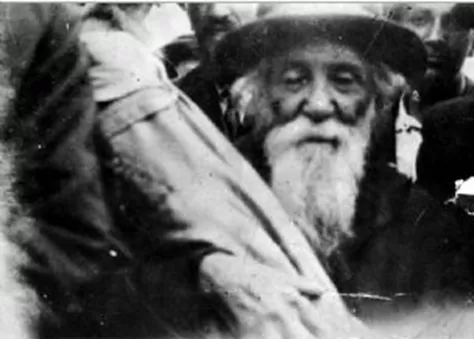
Rabbi Chaim HaLevi Rabinowitz, Iasi
On the eve of the Axis invasion of the Soviet Union, the tension between the Jews and the local population was clearly visible in the air of Iasi, and the poisonous hatred of the Jews was already bubbling in the city. The catalysts for the riots were false rumours that Jews had signaled the Soviet enemy planes. German and Romanian military forces were concentrated in the city (Romania was Germany’s ally), and the opening shot of the events was on the evening of Saturday, June 27, 1941.
Germans, Romanian army forces legionnaires, police forces, and local mobs rioted against thousands of Jews in the streets and homess. Thousands of Jews were imprisoned in the police station. The bloodbath reached its climax on “Black Sunday”, when many of the prisoners were shot at the police station. 4,330 were loaded into the “death wagons” – sealed freight wagons – of which about 2,650 perished on the way, from thirst and lack of oxygen.
As for the victims – there is no exact number, because the community was not given the opportunity to register. According to the available data, the estimate of the dead is about 12,000.[4]
Among the survivors of the pogrom was the Rebbe of Czchow and his family members, but some of those who perished were his followers and the worshipers of his beit midrash (study hall) in Iasi, which was established in 5689 (1929) with his tenure as the Rebbe, and was a centre of Torah and Chassidim.
“The pogrom began on the 3rd of Tammuz in the afternoon in the suburbs of Iasi, but this had not yet become known…On Sunday morning it was learned that Jews were being killed and there was a terrible fear” – these words describe the sequence of bloody events from the mouth of his descendants in the chapters of his history, and from there the story of his miraculous rescue emerges. The Rebbe, as a well-known leader, was a marked target. With his sharp resourcefulness, he managed to evade the rioters. Near his house, Jews barricaded themselves in a shelter, but the Rebbe realized that when the sword of the destroyer is raging, the shelter is not enough. “You have to find a hiding place, and immediately he returned with his houseboy and gabbai (assistant) to his house; with the help of a ladder they went up to the attic, they pulled the ladder after them and closed the attic opening from above. A few moments later, the killers, may their names be blotted out, arrived there, seized all the Jews in the shelter and marched them to the gathering place in the courtyard of the police station, then they went up to the rabbi’s house, searched all the rooms and shouted ‘where is the rabbi, where is the rabbi’, but to their great disappointment, they found no one “ (ibid.).
The event described is one step in the chain of events. The rioters did not despair. Some time after the riot, some Jews managed to return with a “release note” from the police, which turned out to be a trap and an illusion. Even the rabbi was given a note, and he came down from the attic. The rioters returned to the house to check if there were any Jews left to evacuate. “There’s nothing to enter for, there’s no one here – we were already here in the morning,” that’s what they said when he barricaded himself in the house with his family members.
Jewish Iasi, with over a hundred synagogues in it – is no more. The sound of the blood of thousands of the city’s Jews cried out from the mass graves. Pain and sadness were the constant inhabitants of the city’s Jewish streets. In this twilight hour, the Rebbe’s leadership was evident: “The Jewish Jews found it difficult to return to their daily routine. However, our rabbi had in his soul the concept of ‘shaking off the dust’ and did much to encourage and help and comfort the broken hearts…but his compassionate heart could not stand it and on Shavuot of the year 5703 (1943) he became ill” (ibid). Later, he left Iasi with two Torahs that were recovered from the pogrom and arrived in Bucharest, from where they were marked with the destination: the Land of Israel, but it was acquired in in agony…
With the organization of immigration from Romania in the summer of 1944, sailing tickets were obtained with much effort for two of his children, his daughter Faiga Leah – as mentioned above, and his only son, the Rebbe Rabbi Chaim Yosef Moshe z”l. His son’s ticket was taken from him, and thus he was saved. The Torah book that was sent to Israel sank in the depths of the sea. He absorbed the pain of bereavement and grief with a longing for Zion, his eyes and heart were transported to the “Land of the Deer” to feel the comfort of Zion.
- “But you shall not cross over there…” (Deuteronomy 34:4) – Illegal Immigration to the Land of Israel
“A Torah was brought from somewhere and our rabbi entered the dining room with it and those close to him to perform hakafot (dancing) for Simchat Torah, after that when he read the verse in the Torah from the passage for Simchat Torah (Deuteronomy 4:4) ‘This is the land… you have seen it in your eyes and you will not pass over it,’ his eyes welled up with tears” (ibid.).
On September 26, 1947, the 12th of Tishrei 5708, the ships the “Jewish State” and “Geula” (redemption) sailed from the port of Burgas in Bulgaria, side by side. In the hearts of about 4,000 illegal immigrants, there was hope: to the land of our ancestors.
Before the journey began, the “Jewish State” anticipated its arrival at the port of Burgas. Under pressure from illegal immigrants on “Geula,” the train that took them to the port stopped on a side track on the eve of Yom Kippur. They held their daily prayers where they were parked. The journey was indeed arranged with the Bulgarian authorities, but the prolonged stay of the illegal immigrants in their country embarrassed them.
“The Bulgarian officer stood embarrassed and amazed: on both sides of the track stood Jews wrapped in prayer shawls and in holy fear… Disturbed and moved, the officer asked the ‘companion’ with a hidden note in Hebrew: ‘Why didn’t you tell me they were going to Israel?’ It became clear that the officer had been a member of HaShomer HaTzair (a Zionist youth group) before joining the Communist Party” (M. Oren, To Begin Differently, To Live Differently)[5]
The “Jewish State” waited for “Geula” – with its passengers fasting and praying on the ship. “The prayer of Kol Nidrei was held on board in front of a red sun kissing the sea. In the same place, an intense Yizkor prayer service was also held for the victims of the Holocaust…” (ibid.).
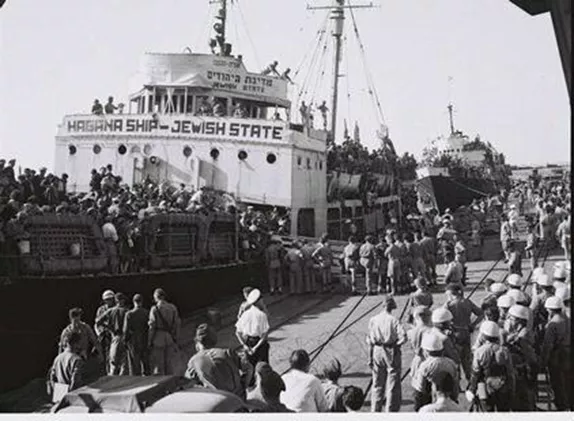
The illegal immigration ship, “The Jewish State,” anchored at the Haifa port prior to its deportation to Cyprus
Among the 2664 illegal immigrants on the “Jewish State,” was the Czchow Rebbe and his family. In his testimony, his son, the Rebbe z”l, told that the Rebbe (i.e. his father) arranged prayers for the holy day on the sides of the lower deck of the ship, and how many people joined the chassidic style prayer service. The mitzvah of happiness on Sukkot and the mitzvah of sitting in a Sukkah were also observed on the ship. Unfortunately, close to the shores of the Land of Israel, as an enemy among its enemies, the British seized the ship and towed it to the port of Haifa. “The passengers were not allowed to go down to the port and our Rebbe performed the Hoshana Raba prayers, the reading of Mishneh Torah, and the Shemini Atzeret prayers (Ohel Kedoshim). The illegal immigrants of the “Jewish State” resisted their arrest and started a struggle during which some were injured.
Liek Jeremiah the prophet at his time, who chose to go into exile with his brothers to the land that was decreed, despite the British offer to take him off the ship due to his health condition, the Rebbe hugged and stuck to to the Torah that was from his study hall, and stood on the deck of the ship in the port of Haifa. At the port, his nephew was waiting for him – Rabbi Shalom Silberfarb, who lived in the city. The Rebbe was comforted when the Torah scroll wrapped in his prayer shawl was entrusted to be kept in the Land of Israel with Rabbi Shalom Silberfarb.
And the Land bade farewell to its prisoners who were transported to Cyrpus.
- “Let the redeemers rejoice. Let the righteous rejoice. In the joy of the Torah” (From a Simchat Torah song): In Exile in Cyprus
The illegal immigrants met at the ancient port of the city of Famagusta – the gateway to the deportation island – on Simchat Torah. Upon their arrival, they began to deal with settling in and arranging registration, receiving a living tent, and obtaining straw for bedding. “However, our rabbi’s concern is completely different, his eyes were focused on how it would be possible to perform the hakafot for Simchat Torah. A Torah was brought from somewhere and our rabbi entered the dining room with his followers to perform the hakafot for Simchat Torah” (ibid.).
Most of the illegal immigrants from the “Jewish State” and “Geula” were housed in the “winter camps”. [6] They were housed in the new camp that was established as rows of tents – “Camp 70”. The Rebbe and his family were also housed in this camp.
Camp 70 was established in Dhekelia, about a kilometer and a half away from the others. In its designation, it was prepared to receive the illegal immigrants from the “Exodus from Europe” ship, who did not arrive. In the early days of the camp, there was a lack of infrastructure and supplies: the water supply was disrupted and difficult, the food did not arrive consistently and the postal system did not function. The arrival of “Geula” and the “Jewish State” was the beginning of the great immigration from Romania, which continued after their arrival in the winter of 5708 (1948) – about 15,000 of the “Pan” immigrants (the “Pan York” and “Pan Crescent” ships).
The Rebbe lived in the camp for about 5 months. His days were filled with prayer and study. In his tent – he sat and studied, crowned with tefillin until midnight. The Rebbe did not change his customs and in the camp his routine began early in the morning, after immersion in the mikvah. As was the custom of his ancestral home, the Rebbe used to wrap himself in a “terksheh” (a prayer shawl containing no linen; it was called “terksheh” because in the past the fabric was imported from Tunis, which was under Turkish control). Since his prayer shawl wrapped the Torah book that he entrusted to the guard, he was found in the camp without a prayer shawl. His son, the latest Rebbe z”l, went every day to a remote camp with great devotion, a distance of about an hour’s walk each way, to bring a “terksheh” from a Jew, who eventually gave it to the Rebbe.
The camp detainees were warmed by the light of his teachings and benefited from his advice. The Rebbe also lit the Chanuka candles with wicks, and the light of the Chanuka emanated from his tent.
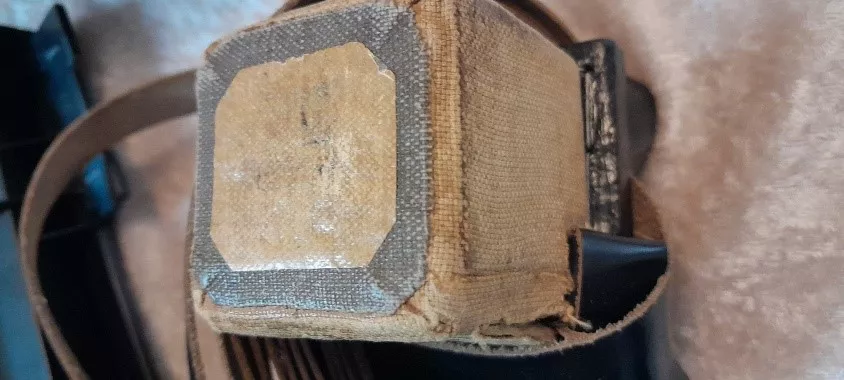
A tefilin case made by one of the illegal immigrants for the son of the Rebbe – The latest Rebbe, Rabbi Chaim Yosef Moshe Kanner
Despite his medical condition, the Rebbe was careful about eating foods that may have been unkosher. For a while he only ate pomegranates. During their stay in Cyprus, as his son testified, all his family members did not eat meat or chicken. The poor diet resulted in severe intestinal disease. His weakness caused him to think that he would not leave Cyprus, but the opposite happened – due to his illness, the British sent him to a hospital in the Land of Israel. On the 11th day of Adar B 5708 (March 22, 1948), he was blessed to be granted amnesty, and his grief and tears were absorbed by the Land of Israel.
His children, the Rebbe z”l and his sister, immigrated to Israel about 2 weeks after him, on the eve of Rosh Chodesh (the first of the month) Nissan. Upon their arrival, they began their search for their father and miraculously met him in Tel Aviv. Their mother, the rebbetzin, arrived in Israel close to Seder night and arranged it for a group of refugees in Hadera.
- “And the gold of the Land is good” (Genesis 2:12) – “There is no Torah like the Torah of the Land of Israel (Beraishit Raba 80:16)”: The Study Hall in Haifa, Chalisa Neighbourhood
The Rebbe’s ambition was to establish a study hall in the style of Czchow-Sanz and Scinawa. When the Chalisa neighborhood was emptied of Arabs in the 5708 (1948) war, he rebuilt his court there. “And the Torah returns to its lodging” (Bava Metzia 85a:19): the Rebbe’s synagogue attracted many worshippers, his house was open to all and many refugees and exilees also gathered there. As was his custom in Iasi, he taught a regular daily lesson, and even added Mishna learning for the uplifting of the souls of the martyrs. Later, the large study hall “Divrei Yechezkel Scinawa” was established on the roof of his house.
After his passing, the leadership of the community was continued by his son, the Rebbe, Rabbi Chaim Yosef Moshe Kanner, who also ran the “Torat Emet” school in Haifa, from which thousands of students graduated. In his last years he moved his residence to the Ramat Shlomo neighborhood of Jerusalem, where he founded the Czhow Beit Midrash (study hall) and many came to hear his teachings.
The Rebbe, Rabbi Avraham Abish Kanner, and his son, the Rebbe, Rabbi Chaim Yosef Moshe Kanner left their mark on the memories of the people of Haifa and in the annals of the city. Their influence is evident in “Haifa Shel Ma’ale” and “Haifa Shel Mata” (upper and lower Haifa).
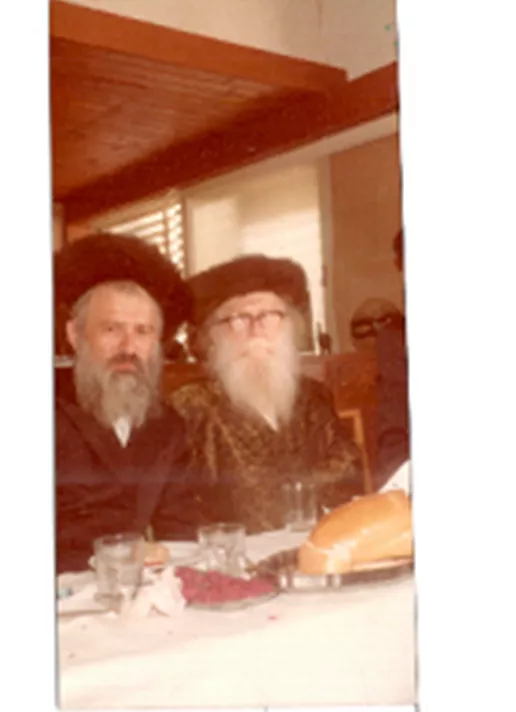
The Rebbe, Rabbi Avraham Abish Kanner and his son, the Rebbe, Rabbi Chaim Yosef Moshe Kanner
[1] Ofer, D., The Journey by Sea, Aliya in the Holocaust Period, Jerusalem 1988, pg. 381
[2] Geller, I., The Jewish Stance of Romanian Jewry in the Holocaust Period, Lod 5663, pg. 401.
[3] Avraham Abish Kanner, the Czchow Rebbe (1894-1983), the son of Rabbi Yaakov Shimshon Kanner, the son-in-law of Rabbi Moshe of Scinawa, the founder of Czchow chassidism, married to the daughter of Rabbi Mordechai Yosef Moshe Moskowitz of Sulice in Botosani. He was appointed the Rebbe of Czhow in Botosani, Iasi (Romania) and in Haifa. In 5714 (1954) he published his book “Ohel Kedoshim” (Tent of the Martyrs): Chassidic Commentaries on the Torah. The Institue for Publishing the Works of Our Holy Rabbis, run by his descendants, published a new version (5771/2011) including chapter of his life stories. My thanks to his grandson, the Rebbe, Rabbi Yisachar Yoel Kanner, the rabbi of the study hall and kollel (yeshiva for adult men) in Ramat Shlomo, for his generosity in sharing information and for the updated version of the book.
[4] The Encyclopedia of the Holocaust (Edited by Israel Gutman), Yad Vashem, Tel Aviv 1990, pg. 580-581; Pinkas HaKehilot Romania (Edited by T. Lavi), Yad Vashem, Jerusalem, 1969, pg. 167-172.
[5] M. Oren, To Begin Differently, To Live Differently, Youth Groups in the Cyprus Illegal Immigrant Camps 1946-1948, “Yad Tabenkin,” Efa’al, 1984, pg. 148.
[6] With thanks to Mr. Amir Rogel – Association of Illegal Immigrants of Cyprus – for his assistance with information.


